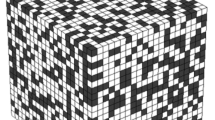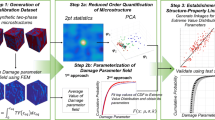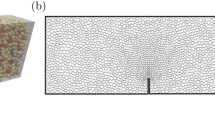Abstract
Reduced-order structure–property (S-P) linkages play a pivotal role in the tailored design of materials for advanced engineering components. There is a critical need to distill these from the simulation datasets aggregated using sophisticated, computationally expensive, physics-based numerical tools (e.g., finite element methods). The recent emergence of materials data science approaches has opened new avenues for addressing this challenge. In this paper, we critically compare the relative merits of the application of four distinct machine learning approaches for their efficacy in extracting microstructure-property linkages from the finite element simulation data aggregated on high-contrast elastic composites with different microstructures. The machine learning approaches selected for the study have included different combinations of local/global and parametric/nonparametric approaches. Furthermore, the nonparametric approaches selected for this study are based on Gaussian Process (GP) models that allow for a formal treatment of uncertainty quantification in the predicted values. The predictive performances of these different approaches have been compared against each other using rigorous cross-validation error metrics. Furthermore, their sensitivity to both the dataset size and dimensionality has been investigated.







Similar content being viewed by others
References
Materials genome initiative for global competitiveness. National science and technology council executive office of the president (2011)
van Schalkwijk W, Scrosati B (2007) Advances in lithium-ion batteries. Springer, Boston
Reed RC (2008) The superalloys: fundamentals and applications. Cambridge University Press, Cambridge
Hasegawa R (2000) Present status of amorphous soft magnetic alloys. J Magn Magn Mater 215:240–245
Furrer D, Fecht H (1999) Ni-based superalloys for turbine discs. JOM 51(1):14–17
Pollock T, Tin S (2006) Nickel-based superalloys for advanced turbine engines: chemistry, microstructure and properties. J Propul Power 22(2):361–374
Lu L, Han X, Li J, Hua J, Ouyang M (2013) A review on the key issues for lithium-ion battery management in electric vehicles. J Power Sources 226:272–288
Integrated computational materials engineering: a transformational discipline for improved competitiveness and national security. The National Academies Press, Washington (2008)
Mueller T, Kusne AG, Ramprasad R (2015) Machine learning in materials science: recent progress and emerging applications. Rev Comput Chem 29:186–273
Yang N, Yee J, Zheng B, Gaiser K, Reynolds T, Clemon L, Lu W, Schoenung J, Lavernia E (2017) Process-structure-property relationships for 316l stainless steel fabricated by additive manufacturing and its implication for component engineering. J Therm Spray Tech 26(4):610–626
Kalidindi S (2015) Hierarchical materials informatics: novel analytics for materials data. Elsevier, Boston
Yabansu YC, Steinmetz P, Hötzer J, Kalidindi S, Nestler B (2017) Extraction of reduced-order process-structure linkages from phase-field simulations. Acta Mater 124:182–194
Gomberg JA, Medford AJ, Kalidindi S (2017) Extracting knowledge from molecular mechanics simulations of grain boundaries using machine learning. Acta Mater 133:100–108
Gorgannejad S, Gahrooei MR, Paynabar K, Neu R (2019) Quantitative prediction of the aged state of ni-base superalloys using pca and tensor regression. Acta Mater 165:259–269
Olson GB (1997) Computational design of hierarchically structured materials. Science 277(5330):1237–1242
Panchal JH, Kalidindi S, McDowell DL (2013) Key computational modeling issues in integrated computational materials engineering. Comput Aided Des 45(1):4–25
Nellippallil AB, Rangaraj V, Gautham B, Singh AK, Allen JK, Mistree F (2017) A goal-oriented, inverse decision-based design method to achieve the vertical and horizontal integration of models in a hot rod rolling process chain. In: ASME 2017 International design engineering technical conferences and computers and information in engineering conference. American Society of Mechanical Engineers, pp v02BT03a003–v02BT03a003
Fullwood D, Niezgoda S, Adams BL, Kalidindi S (2010) Microstructure sensitive design for performance optimization. Prog Mater Sci 55(6):477–562
Sanchez-Lengeling B, Aspuru-Guzik A (2018) Inverse molecular design using machine learning: Generative models for matter engineering. Science 361(6400):360–365
McDowell DL, Kalidindi S (2016) The materials innovation ecosystem: a key enabler for the materials genome initiative. MRS Bulletin 41(4):326–337
Mortazavi B, Baniassadi M, Bardon J, Ahzi S (2013) Modeling of two-phase random composite materials by finite element, mori–tanaka and strong contrast methods. Compos Part B Eng 45(1):1117–1125
Argatov II, Sabina FJ (2017) A two-phase self-consistent model for the grid indentation testing of composite materials. Int J Eng Sci 121:52–59
Duan H, Wang JX, Huang Z, Karihaloo BL (2005) Size-dependent effective elastic constants of solids containing nano-inhomogeneities with interface stress. J Mech Phys Solids 53(7):1574–1596
Fu SY, Feng XQ, Lauke B, Mai YW (2008) Effects of particle size, particle/matrix interface adhesion and particle loading on mechanical properties of particulate–polymer composites. Compos Part B 39(6):933–961
Trofimov A, Drach B, Sevostianov I (2017) Effective elastic properties of composites with particles of polyhedral shapes. Int J Solids Struct 120:157–170
Fullwood D, Adams BL, Kalidindi S (2008) A strong contrast homogenization formulation for multi-phase anisotropic materials. J Mech Phys Solids 56(6):2287–2297
Pham D, Torquato S (2003) Strong-contrast expansions and approximations for the effective conductivity of isotropic multiphase composites. J Appl Phys 94(10):6591–6602
Mikdam A, Makradi A, Ahzi S, Garmestani H, Li DS, Remond Y (2009) Effective conductivity in isotropic heterogeneous media using a strong-contrast statistical continuum theory. J Mech Phys Solids 57(1):76–86
Adams BL, Kalidindi S, Fullwood D (2012) Microstructure sensitive design for performance optimization. Butterworth-Heinemann, Boston
Fernandez-Zelaia P, Joseph VR, Kalidindi S, Melkote SN (2018) Estimating mechanical properties from spherical indentation using bayesian approaches. Mater Des 147:92–105
Paulson NH, Priddy MW, McDowell DL, Kalidindi S (2017) Reduced-order structure-property linkages for polycrystalline microstructures based on 2-point statistics. Acta Mater 129:428–438
Li X, Xu Y, Chen S (2016) Computational homogenization of effective permeability in three-phase mesoscale concrete. Constr Build Mater 121:100–111
Pinz M, Weber G, Lenthe W, Uchic M, Pollock T, Ghosh S (2018) Microstructure and property based statistically equivalent rves for intragranular γ- γ’microstructures of ni-based superalloys. Acta Mater 157:245–258
Latypov MI, Kalidindi S (2017) Data-driven reduced order models for effective yield strength and partitioning of strain in multiphase materials. J Comput Phys 346(13):242–261
Gupta A, Cecen A, Goyal S, Singh AK, Kalidindi S (2015) Structure–property linkages using a data science approach: application to a non-metallic inclusion/steel composite system. Acta Mater 91:239–254
Jung J, Yoon JI, Park HK, Kim JY, Kim HS (2019) Bayesian approach in predicting mechanical properties of materials: Application to dual phase steels. Mater Sci Eng A 743:382–390
Iskakov A, Yabansu YC, Rajagopalan S, Kapustina A, Kalidindi S (2018) Application of spherical indentation and the materials knowledge system framework to establishing microstructure-yield strength linkages from carbon steel scoops excised from high-temperature exposed components. Acta Mater 144:758–767
Altschuh P, Yabansu YC, Hötzer J, Selzer M, Nestler B, Kalidindi S (2017) Data science approaches for microstructure quantification and feature identification in porous membranes. J Membr Sci 540(1):88–97
Mangal A, Holm EA (2018) Applied machine learning to predict stress hotspots i: face centered cubic materials. Int J Plast 111:122–134
Friedman J, Hastie T, Tibshirani R (2001) The elements of statistical learning, vol 1. Springer series in statistics. New York, NY, USA
Cecen A, Dai H, Yabansu YC, Kalidindi S, Song L (2018) Material structure-property linkages using three-dimensional convolutional neural networks. Acta Mater 146:76–84
Yang Z, Yabansu YC, Al-Bahrani R, Liao WK, Choudhary AN, Kalidindi SR, Agrawal A (2018) Deep learning approaches for mining structure-property linkages in high contrast composites from simulation datasets. Comput Mater Sci 151:278–287
Ryczko K, Mills K, Luchak I, Homenick C, Tamblyn I (2018) Convolutional neural networks for atomistic systems. Comput Mater Sci 149:134–142
Kondo R, Yamakawa S, Masuoka Y, Tajima S, Asahi R (2017) Microstructure recognition using convolutional neural networks for prediction of ionic conductivity in ceramics. Acta Mater 141:29–38
Fernandez-Zelaia P, Melkote SN (2019) Statistical calibration and uncertainty quantification of complex machining computer models. Int J Mach Tools Manuf 136:45–61
Yang Z, Yabansu YC, Jha D, Liao WK, Choudhary AN, Kalidindi SR, Agrawal A (2019) Establishing structure-property localization linkages for elastic deformation of three-dimensional high contrast composites using deep learning approaches. Acta Mater 166:335–345
Yabansu YC, Kalidindi S (2015) Representation and calibration of elastic localization kernels for a broad class of cubic polycrystals. Acta Mater 94:26–35
Landi G, Niezgoda S, Kalidindi S (2010) Multi-scale modeling of elastic response of three-dimensional voxel-based microstructure datasets using novel dft-based knowledge systems. Acta Mater 58(7):2716–2725
Kalidindi S, Niezgoda S, Landi G, Vachhani S, Fast T (2010) A novel framework for building materials knowledge systems. Comput Mater Continua 17(2):103–125
Cecen A, Yabansu YC, Kalidindi S (2018) A new framework for rotationally invariant two-point spatial correlations in microstructure datasets. Acta Mater 158:53–64
Niezgoda S, Kanjarla AK, Kalidindi S (2013) Novel microstructure quantification framework for databasing, visualization, and analysis of microstructure data. Integr Mater Manuf Innov 2(1):3
Niezgoda S, Fullwood D, Kalidindi S (2008) Delineation of the space of 2-point correlations in a composite material system. Acta Mater 56(18):5285–5292
Fullwood D, Niezgoda S, Kalidindi S (2008) Microstructure reconstructions from 2-point statistics using phase-recovery algorithms. Acta Mater 56(5):942–948
Turner DM, Niezgoda S, Kalidindi S (2016) Efficient computation of the angularly resolved chord length distributions and lineal path functions in large microstructure datasets. Model Simul Mater Sci Eng 24(7):075,002
Brough DB, Wheeler D, Kalidindi S (2017) Materials knowledge systems in python—a data science framework for accelerated development of hierarchical materials. Integr Mater Manuf Innov 6(1):36–53
Brough DB, Kannan A, Haaland B, Bucknall DG, Kalidindi S (2017) Extraction of process-structure evolution linkages from x-ray scattering measurements using dimensionality reduction and time series analysis. Integr Mater Manuf Innov 6(2):147–159
Bishop CM (2006) Pattern recognition and machine learning. Springer, Berlin
Witten IH, Frank E, Hall MA, Pal CJ (2016) Data mining: practical machine learning tools and techniques. Morgan Kaufmann, Cambridge
Binois M, Gramacy RB, Ludkovski M (2018) Practical heteroskedastic gaussian process modeling for large simulation experiments. J Comput Graph Stat 27(4):808–821
Tibshirani R (1996) Regression shrinkage and selection via the lasso. J R Stat Soc Ser B Methodol 58 (1):267–288
Härdle W (1990) Applied nonparametric regression 19. Cambridge University Press, Cambridge
Kvam PH, Vidakovic B (2007) Nonparametric statistics with applications to science and engineering, vol 653. Wiley, New Jersey
Cleveland WS (1979) Robust locally weighted regression and smoothing scatterplots. J Am Stat Assoc 74 (368):829–836
Cleveland WS, Devlin SJ (1988) Locally weighted regression: an approach to regression analysis by local fitting. J Am Stat Assoc 83(403):596–610
Ho TK (1995) Random decision forests. In: 1995 proceedings of the third international conference on document analysis and recognition, vol 1. IEEE, pp 278–282
Krige DG (1951) A statistical approach to some basic mine valuation problems on the witwatersrand. J South Afr Inst Min Metall 52(6):119–139
Matheron G (1963) Principles of geostatistics. Econ Geol 58(8):1246–1266
Sacks J, Welch WJ, Mitchell TJ, Wynn HP (1989) Design and analysis of computer experiments. Stat Sci 4(4):409–435
Rasmussen CE, Williams CK (2006) Gaussian processes for machine learning, vol 1. MIT Press, Cambridge
Ba S, Joseph VR et al (2012) Composite gaussian process models for emulating expensive functions. Ann Appl Stat 6(4):1838–1860
Joseph VR (2006) Limit kriging. Technometrics 48(4):458–466
Tuo R, Wu CJ, Yu D (2014) Surrogate modeling of computer experiments with different mesh densities. Technometrics 56(3):372–380
Santner TJ, Williams BJ, Notz WI (2013) The design and analysis of computer experiments. Springer, New York
Chen H, Loeppky JL, Welch WJ (2017) Flexible correlation structure for accurate prediction and uncertainty quantification in bayesian gaussian process emulation of a computer model. SIAM/ASA J Uncertain Quantif 5 (1):598–620
Banerjee S, Gelfand AE, Finley AO, Sang H (2008) Gaussian predictive process models for large spatial data sets. J R Stat Soc Ser B Stat Methodol 70(4):825–848
Gramacy RB, Lee HKH (2008) Bayesian treed gaussian process models with an application to computer modeling. J Am Stat Assoc 103(483):1119–1130
Duvenaud DK, Nickisch H, Rasmussen CE (2011) Additive gaussian processes. In: Advances in neural information processing systems, pp 226–234
Gramacy RB, Apley DW (2015) Local gaussian process approximation for large computer experiments. J Comput Graph Stat 24(2):561–578
Gramacy RB (2015) lagp: large-scale spatial modeling via local approximate gaussian processes in r. Journal of Statistical Software (available as a vignette in the laGP package)
Breiman L (2001) Random forests. Mach Learn 45(1):5–32
Chipman HA, George EI, McCulloch RE, et al. (2010) BART: Bayesian additive regression trees. Ann Appl Stat 4(1):266– 298
Yabansu YC, Kalidindi SR (2019) Microscale volume elements and their effective/homogenized stiffness parameter for high contrast 3-d elastic composite. https://matin.gatech.edu/resources/309
Funding
YCY and SRK received support from NSF 1761406. PFZ received financial support of the work from the Morris M. Bryan, Jr. Professorship.
Author information
Authors and Affiliations
Corresponding author
Additional information
Publisher’s Note
Springer Nature remains neutral with regard to jurisdictional claims in published maps and institutional affiliations.
Rights and permissions
About this article
Cite this article
Fernandez-Zelaia, P., Yabansu, Y.C. & Kalidindi, S.R. A Comparative Study of the Efficacy of Local/Global and Parametric/Nonparametric Machine Learning Methods for Establishing Structure–Property Linkages in High-Contrast 3D Elastic Composites. Integr Mater Manuf Innov 8, 67–81 (2019). https://doi.org/10.1007/s40192-019-00129-4
Received:
Accepted:
Published:
Issue Date:
DOI: https://doi.org/10.1007/s40192-019-00129-4




